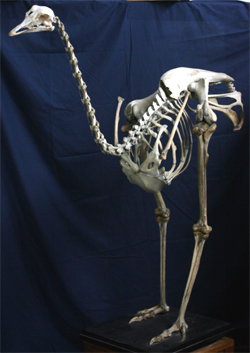
FLIGHTLESS BIRDS
There are several lineages of flightless birds descended from different flying ancestors. Their bodies have been dramatically redesigned to remove all the structural restrictions of flight. The keel of the sternum has been lost and the heavy flight muscles have disappeared. As body weight is no longer a constraint, flightless birds may be very large. Flightless birds almost always evolved on islands where predators were few, like kiwis in New Zealand. Those, like the ostrich, emu, cassowary and rhea, which live on continents today are large and can outrun predators. Some extinct flightless birds were enormous.

1. Model of elephant bird (behind) and moa (in front). The elephant bird of Madagascar, the largest bird that ever lived, was 6 feet tall; the giant moas of New Zealand weighed more than 500 lbs.
2. Young Emu, Dromaius novaehollandiae, and emu egg (O. Casuariformes). Emus occur in Australia. They prefer a very nutritious diet and may migrate long distances in search of food sources. The male bird incubates and cares for the chicks. This is a young emu; adults reach a height of 5 feet.
3. Kiwi, Apteryx sp., (O. Apterygiformes). Kiwis prefer a bushy habitat and are adapted for nocturnal activity: they are famous among birds but have been seen by few. They use their sense of smell rather than sight to investigate their surroundings. The very long bill probes the ground for food. Kiwis lay only one large egg, which is incubated by the male.
4. Cassowary, Casaurius sp., skull and egg (O. Casuariformes). Cassowaries live in forests in New Guinea. They feed mainly on the fruit of forest trees which they eat whole. Since they cannot fly they are dependent on fallen fruit on the forest floor. They are solitary birds forming pairs only during the breeding season. As with other flightless birds, the male incubates the eggs and looks after the chicks for about a year before returning to a solitary life.
5. Ostrich, Struthio camelus, skull and egg (O. Struthioniformes). Ostriches live in the African savannah and deserts. They are mainly vegetarians feeding on shoots, flowers, leaves and seeds. Both male and female share in incubating the eggs and caring for the chicks.

Our ostrich skeleton is 5 feet (150 cm) tall and 2 feet ( 60 cm) wide where its legs join its body. Its skull is 10 inches (25 cm) long and its feet are 12 inches (30 cm) long. The bones that support the tips of its wings are missing.






